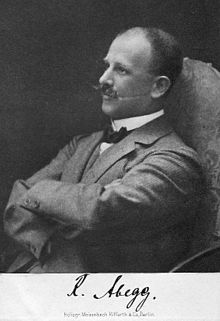Richard Abegg
| Richard Abegg | |
|---|---|

Richard Wilhelm Heinrich Abegg (1869–1910)
|
|
| Born |
January 9, 1869 Danzig, Prussia |
| Died | April 3, 1910 (aged 41) Köslin, German Empire |
| Residence | Germany |
| Nationality | German |
| Fields | Chemist |
| Institutions |
University of Göttingen Wrocław University of Technology |
| Alma mater |
University of Kiel University of Tübingen University of Berlin |
| Doctoral advisor | August Wilhelm von Hofmann |
| Doctoral students | Clara Immerwahr |
| Known for | Abegg's rule |
| Signature | |
Richard Wilhelm Heinrich Abegg (January 9, 1869 – April 3, 1910) was a German chemist and pioneer of valence theory. He proposed that the difference of the maximum positive and negative valence of an element tends to be eight. This has come to be known as Abegg's rule. He was a gas balloon enthusiast, which caused his death at the age of 41 when he crashed in his balloon in Silesia.
Abegg received his PhD on July 19, 1891 as the student of August Wilhelm von Hofmann at the University of Berlin. Abegg learned organic chemistry from Hofmann, but one year after finishing his PhD degree he began researching physical chemistry while studying with Friedrich Wilhelm Ostwald in Leipzig, Germany. Abegg later served as private assistant to Walther Nernst at the University of Göttingen and to Svante Arrhenius at the .
Abegg discovered the theory of freezing-point depression and anticipated Gilbert Newton Lewis's octet rule by revealing that the lowest and highest oxidation states of elements often differ by eight. He researched many topics in physical chemistry, including freezing points, the dielectric constant of ice, osmotic pressures, oxidation potentials, and complex ions.
...
Wikipedia

